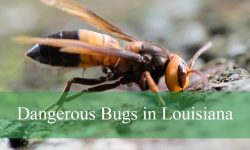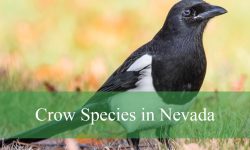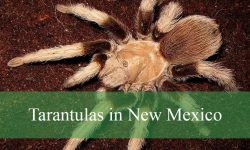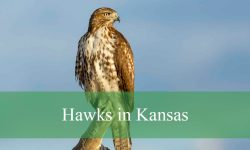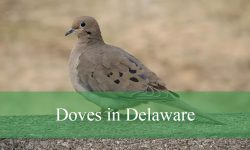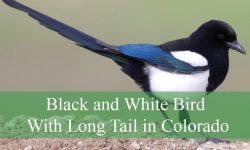Virginia’s mix of forests, grasslands, and coastal areas provides a perfect home for many gray-colored birds. These subtle-toned species may lack the brilliance of more colorful birds, but they often stand out through their distinctive calls, behaviors, and graceful movements.
In this guide, you’ll discover 22 gray birds commonly seen across Virginia, with descriptions to help you recognize each one. You’ll learn where they live, how they behave, and what features to look for, whether you’re exploring a local park or simply watching your feeders at home. From the lively Eastern Kingbird to the quiet charm of the Gray Catbird, each bird brings something special to the landscape.
Common Gray Birds You Can See in Virginia
Carolina Chickadee
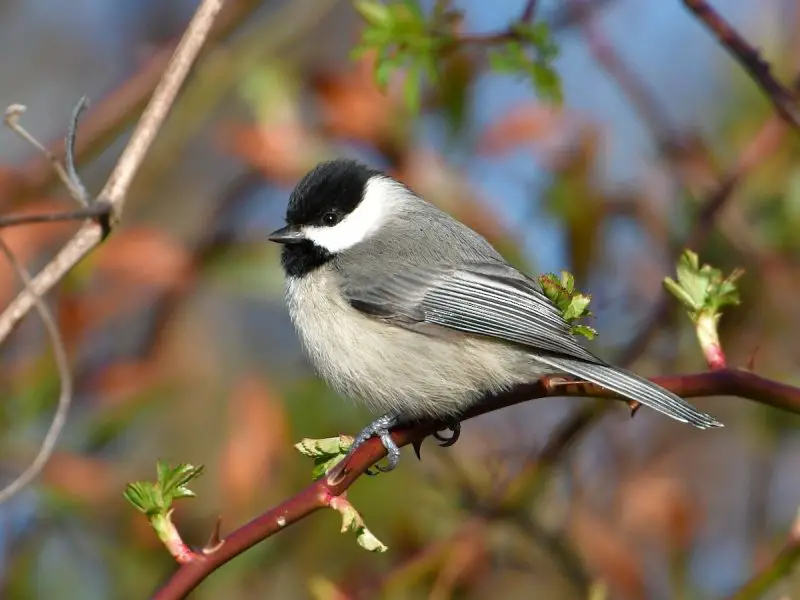
The Carolina Chickadee is a small songbird measuring about 4.5 inches long, easily recognized by its soft gray body contrasted with a distinct black cap and bib. Its short, stout bill and rounded shape give it a friendly, approachable look. This bird is very active and curious, commonly seen flitting through Virginia’s deciduous forests, suburban yards, and city parks. It moves quickly, often hopping from branch to branch in search of food or shelter.
Carolina Chickadees are year-round residents in Virginia and adapt well to different habitats, including wooded areas and residential neighborhoods. Their diet consists mainly of insects, spiders, and seeds, and they are frequent visitors to backyard feeders, especially during winter when natural food sources become scarce. Their signature “chick-a-dee-dee-dee” call is not only a common sound in Virginia but also serves as a complex warning system within their flocks.
Remarkably intelligent, Carolina Chickadees have excellent spatial memory, allowing them to remember hundreds of hidden seed caches. They also adjust their calling behavior depending on the level of danger, alerting others to predators or safe conditions. This adaptability and intelligence make them one of Virginia’s most fascinating and beloved small birds.
Northern Mockingbird
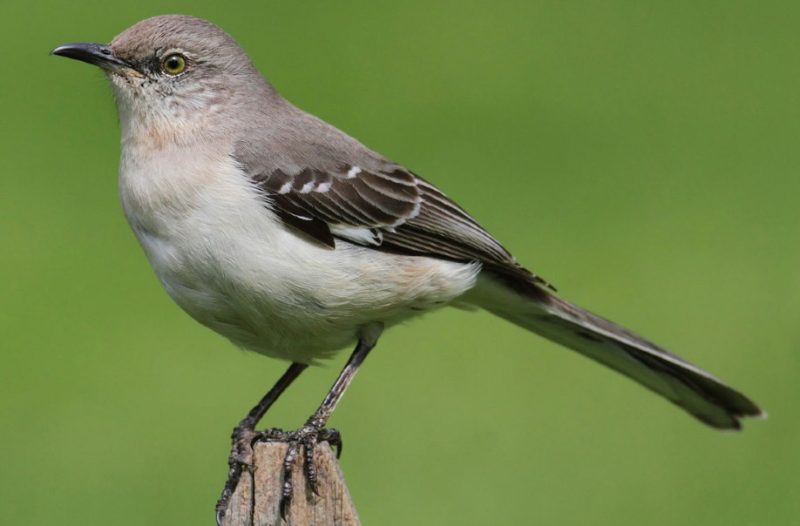
The Northern Mockingbird is a medium-sized bird, about 10 inches long, covered in smooth gray feathers with prominent white patches on its wings and tail that flash when it takes flight. Known for its extraordinary vocal ability, it can mimic the songs of other birds, insects, and even mechanical noises, making it one of the most versatile singers in Virginia. Its adaptability to human-altered environments has allowed it to thrive across urban, suburban, and rural areas.
This species is a year-round resident throughout Virginia and often perches in open, elevated spots such as fences, rooftops, and telephone wires to deliver its extensive repertoire of songs. Mockingbirds are highly territorial and will aggressively defend their nesting sites against other birds and potential threats. Their diet includes a wide variety of insects, berries, and fruits, helping them stay well-fed throughout the year.
A fascinating fact about Northern Mockingbirds is that individual birds can learn and perform up to 200 different song variations, repeating each phrase several times before moving on to a new one. Their spectacular vocal performance and bold behavior make them a favorite among Virginia birdwatchers and an unmistakable presence in backyards and natural areas.
Gray Catbird
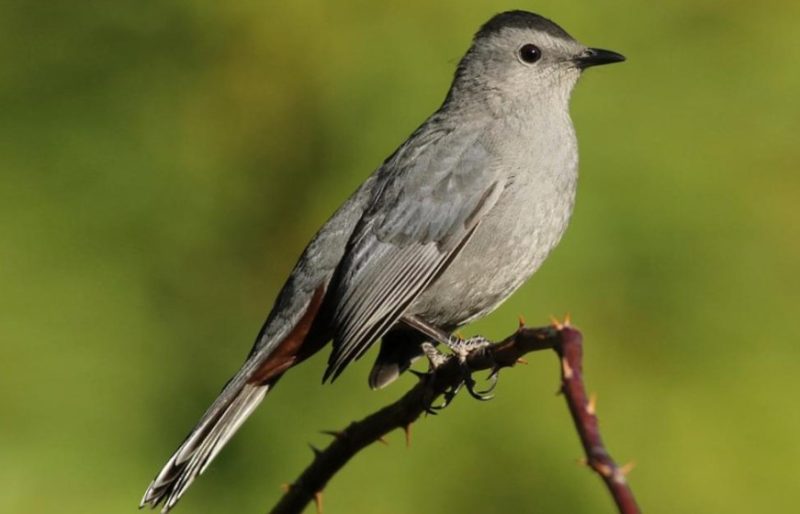
The Gray Catbird is a sleek, medium-sized songbird approximately 8 inches long, with a smooth slate-gray plumage contrasted by a distinctive black cap and rusty undertail patch. It has a slender, slightly curved bill well suited for gleaning insects and berries from dense shrubs. In Virginia, Gray Catbirds are commonly found during the spring and summer months in habitats such as thick brush, gardens, and forest edges, where they forage and nest.
Known for its distinctive cat-like “mew” call, this bird belongs to the mimid family, which includes mockingbirds and thrashers. It is an exceptional mimic, incorporating a variety of whistles, clicks, and imitations of other bird calls into its complex songs that can last several minutes. Alongside insects, its diet also consists of various fruits and berries, making it a frequent visitor to backyard feeders, especially during late summer.
One intriguing aspect of the Gray Catbird’s behavior is its ability to recognize and reject cowbird parasitic eggs, a rare trait among songbirds. This intelligence, combined with its mysterious yet melodic vocalizations, makes the Gray Catbird a captivating species to observe in Virginia’s suburban and woodland areas.
White-throated Sparrow
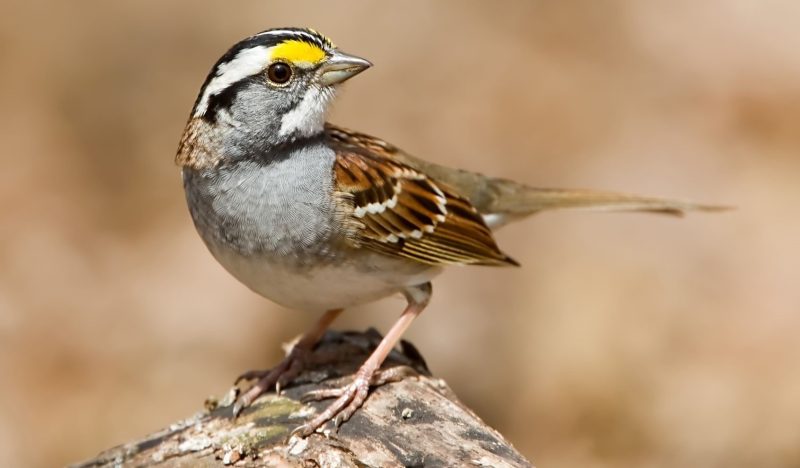
The White-throated Sparrow is a plump, strikingly patterned bird about 7 inches long, easily identified by its grayish-brown body, bright white throat patch, and bold black-and-white stripes on its head. A small yellow spot between the eye and bill adds a touch of color to its otherwise muted appearance. These sparrows are primarily winter visitors in Virginia, often arriving in late fall and staying through early spring.
They favor brushy understories, forest edges, and backyards with thick leaf litter where they forage for a mix of seeds, insects, and berries. Their distinctive song, often described as “Oh-sweet-Canada-Canada,” can be heard clearly even when the bird is hidden in dense cover, making auditory cues crucial for locating them. They travel in small flocks and are often seen scratching at the ground while searching for food.
An interesting genetic feature of White-throated Sparrows is their two color morphs: white-striped and tan-striped. These morphs tend to mate assortatively, meaning white-striped birds usually pair with tan-striped ones, adding complexity to their social structure. This genetic variation has been a popular subject of study among ornithologists monitoring winter bird populations in Virginia.
Eastern Phoebe
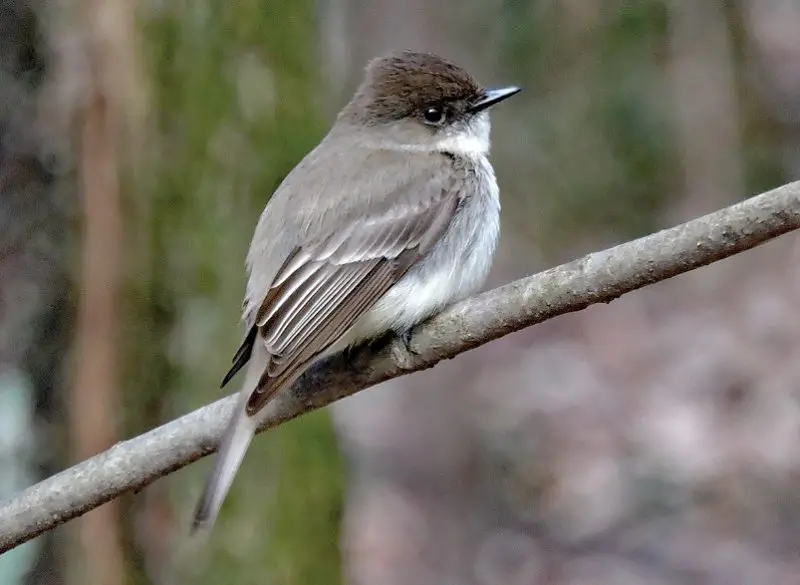
The Eastern Phoebe is a modestly colored flycatcher about 6.5 inches long, with grayish-brown upperparts and a pale, whitish belly. It has a rounded body and a habit of frequently flicking its tail downward while perched. Among the first flycatchers to return to Virginia in early spring, Eastern Phoebes often build their nests on man-made structures such as bridges, barns, or porch ceilings, showing little fear of human proximity.
Their primary feeding strategy involves perching quietly on low branches before making quick flights, or sallies, to catch flying insects midair. As the seasons progress, they also consume spiders and occasionally small berries. In southern Virginia, they can be found year-round, while northern populations migrate south for the winter.
A fun fact about the Eastern Phoebe is that it was the first North American bird to be scientifically banded, an early effort in ornithological study dating back to the 1800s. Its willingness to nest near humans and characteristic tail-bobbing behavior make it an easily recognizable and welcome presence in Virginia’s backyards and rural areas.
Mourning Dove

The Mourning Dove is a slender, graceful bird about 11 inches long, with soft grayish-brown plumage and distinctive black spots on its wings. Its long, pointed tail features white edges that are visible during flight. This dove is one of the most widespread and commonly seen birds in Virginia, often spotted perched on power lines, fences, or quietly feeding on the ground in open fields and backyards. Their gentle, mournful cooing calls give them their name and are a familiar sound throughout the state.
Mourning Doves primarily feed on seeds, favoring grains, grasses, and weed seeds that they find on the ground. They are often seen in pairs or small groups, especially at feeding stations where they prefer flat surfaces to eat. Despite their soft appearance, these birds are swift flyers and can quickly escape predators with their sudden bursts of speed. Their diet is supplemented occasionally by small insects, which provide protein especially during breeding season.
A notable behavior of Mourning Doves is their ability to produce “crop milk,” a nutrient-rich secretion used to feed their young, similar to pigeons. They build simple nests on tree branches, ledges, or even human-made structures. Their adaptability to urban and rural environments makes them a beloved backyard visitor for many bird enthusiasts in Virginia.
Blue Jay
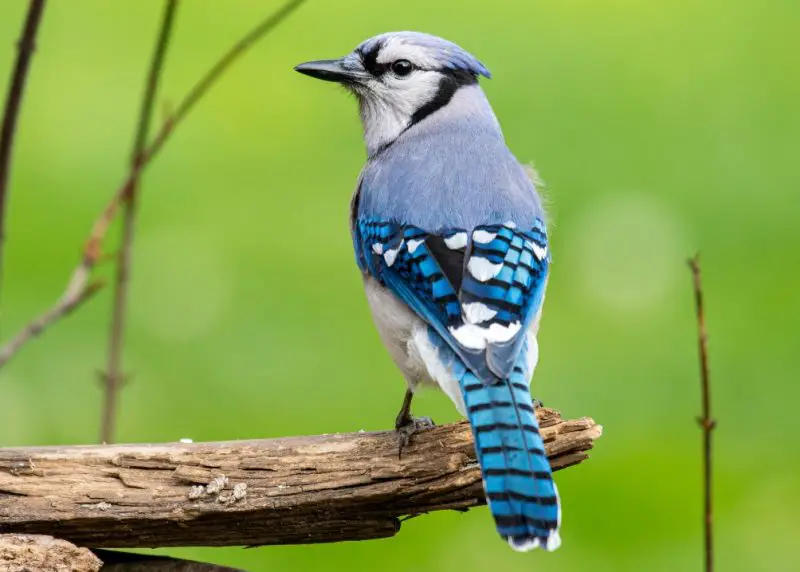
The Blue Jay is a striking bird roughly 11 inches long, easily recognized by its bright blue upperparts, white chest, and bold black markings around the neck and face. It has a prominent crest on its head which it raises or lowers depending on mood or threat level. Common across Virginia, Blue Jays inhabit forests, woodlands, and suburban areas, often making their presence known with loud, harsh calls that can carry for long distances.
Blue Jays are omnivores with a varied diet that includes nuts, seeds, insects, small vertebrates, and occasionally eggs or nestlings of other birds. They are particularly fond of acorns and are known for caching food to eat later. This caching behavior plays an important role in forest ecology, as some forgotten acorns grow into new trees. Blue Jays are intelligent and social birds, often seen in family groups and known for their complex communication.
One fascinating fact about Blue Jays is their ability to mimic the calls of hawks, which they may use to scare off other birds or predators. Despite their sometimes aggressive behavior, Blue Jays also contribute positively by alerting other birds to dangers and by dispersing seeds. Their vibrant colors and bold personality make them a memorable sight for birdwatchers in Virginia.
Tufted Titmouse
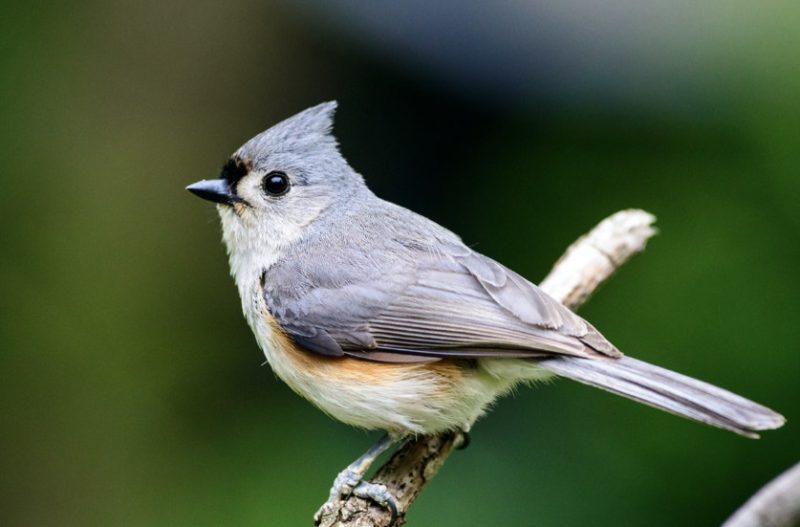
The Tufted Titmouse is a small, stocky bird about 6 inches long with soft gray plumage, a white belly, and a distinct crest on its head that gives it a curious and lively appearance. It has large black eyes and a small, stout bill ideal for cracking seeds. In Virginia, Tufted Titmice are common residents in deciduous and mixed forests, as well as suburban neighborhoods, where they are frequently seen flitting energetically through trees and shrubs.
These birds primarily feed on insects, spiders, seeds, and nuts, often visiting backyard feeders that offer sunflower seeds or suet. They are known for their inquisitive nature and can become quite tame, sometimes even taking food directly from a person’s hand. Tufted Titmice are year-round residents in Virginia and form small family groups outside the breeding season, communicating with a variety of clear whistles and calls.
A fun behavior of the Tufted Titmouse is its habit of caching food in tree crevices and under bark to eat later. This behavior helps the bird survive harsh winters and contributes to seed dispersal. Their cheerful calls and lively movements add vibrancy to Virginia’s woodlands and backyard habitats.
Downy Woodpecker

The Downy Woodpecker is the smallest woodpecker in North America, measuring about 6 to 7 inches in length. It has a predominantly black-and-white plumage, with a white belly and back spotted with black stripes, and males sport a small red patch on the back of the head. This adaptable bird is a common sight across Virginia in forests, parks, and residential areas, where it can be seen clinging to tree trunks and branches as it searches for food.
Downy Woodpeckers feed mainly on insects, including beetle larvae and ants hidden beneath bark, but they also consume seeds and berries, especially during winter. Their characteristic behavior includes rapid, repeated drumming on trees, which serves both to locate food and communicate with other woodpeckers. They excavate small nest cavities in dead wood or decaying trees, often reusing these sites year after year.
Despite their small size, Downy Woodpeckers play a crucial ecological role by controlling insect populations and helping to create nesting sites for other cavity-dependent species. Their striking black and white pattern and rhythmic drumming make them one of Virginia’s most charming and recognizable backyard birds.
Northern Flicker
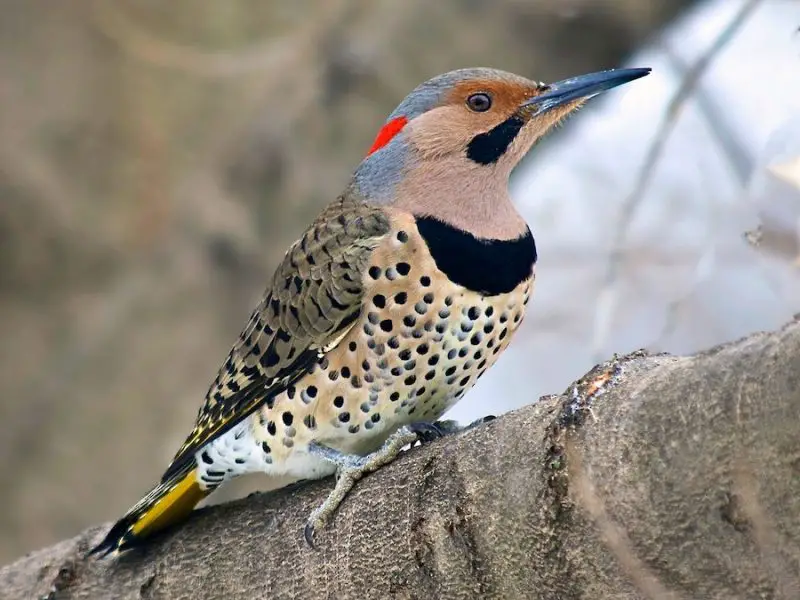
The Northern Flicker is a large woodpecker species about 12 inches long, with a brownish-gray body adorned with black spots and bars and a distinctive black crescent on the chest. Unlike many woodpeckers, Flickers spend much of their time foraging on the ground for ants and beetles. In Virginia, they inhabit woodlands, open fields, and suburban areas, often seen perching on telephone poles or hopping across lawns.
Their diet consists largely of ants and other ground insects, which they extract by digging with their strong bills. Flickers also consume fruits and seeds when insects are less available. They nest in tree cavities, which they excavate themselves, providing essential shelter for their young. Their loud, ringing call and distinctive “wick-a-wick-a-wick” drumming are common sounds in Virginia’s forests and backyards.
A notable fact about Northern Flickers is their striking red or yellow shafted wing and tail feathers, which flash brightly in flight. This, along with their unique feeding behavior, sets them apart from other woodpeckers. Their presence adds both color and lively activity to the natural landscape of Virginia.
Red-bellied Woodpecker
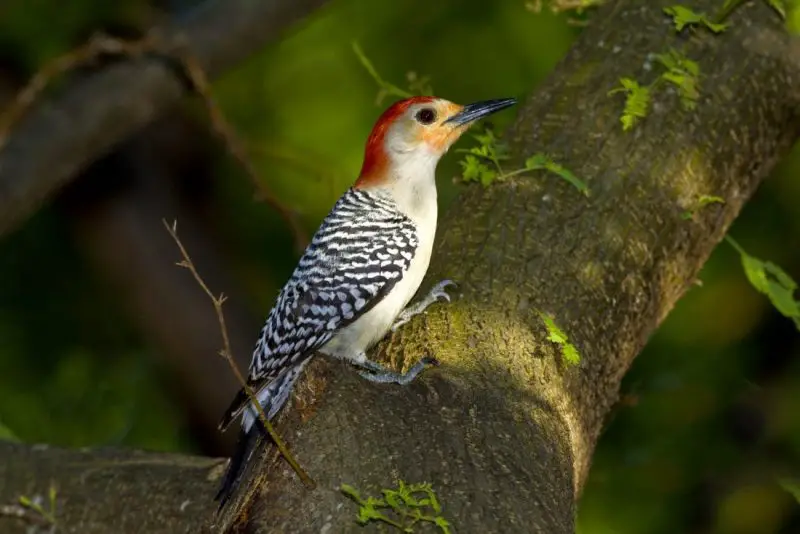
The Red-bellied Woodpecker is a medium-sized woodpecker, about 9 inches long, with striking black and white barred patterns on its back and wings. Its pale face contrasts with a bright red cap that extends down the nape in males and slightly less in females. Despite its name, the red on its belly is faint and often hard to see. This bird is common in Virginia’s woodlands, suburban areas, and parks where it drills into trees to find insects or excavate nesting cavities.
Its diet is varied, consisting of insects, fruits, nuts, and seeds. Red-bellied Woodpeckers are also known to visit backyard feeders, especially those offering suet or peanuts. They use their strong bills to hammer into bark and wood, searching for beetle larvae and ants hiding beneath. Their loud, rolling “churr” call and drumming on trees are familiar sounds in Virginia’s forests.
These woodpeckers are highly territorial and may aggressively defend feeding sites. They play an important ecological role by controlling insect populations and creating nesting sites used later by other birds and mammals. Their bold coloration and energetic behavior make them a favorite among birdwatchers in Virginia.
American Crow
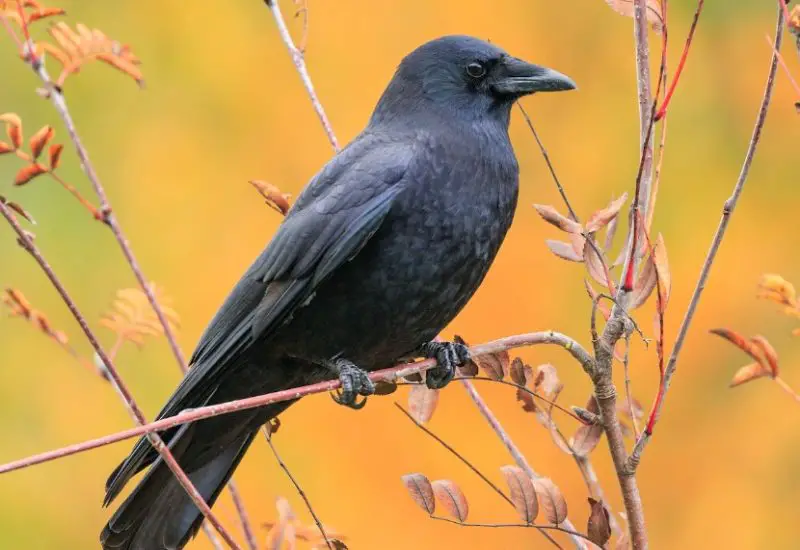
The American Crow is a large, all-black bird about 17 inches long, with glossy feathers and a robust build. It is highly adaptable and common throughout Virginia’s urban, suburban, and rural areas. Known for its intelligence and complex social behavior, the American Crow often forms large flocks, especially in the winter months, where they roost communally for warmth and safety.
American Crows are omnivorous and opportunistic feeders, consuming a wide range of foods including insects, small animals, carrion, grains, and human scraps. Their problem-solving skills and ability to use tools are well-documented, making them one of the smartest bird species. They communicate with a variety of caws and calls to coordinate group activities and warn of predators.
These birds have strong family bonds and often help raise the young of other pairs. While sometimes considered pests due to their loud calls and scavenging habits, they provide important ecological benefits by cleaning up carrion and controlling insect populations. Their presence is an unmistakable part of Virginia’s avian landscape.
House Finch

The House Finch is a small songbird around 5 inches long, notable for the males’ bright red head and chest, while females display streaked brown plumage. Originally native to the western United States, House Finches have successfully expanded eastward and are now common residents in Virginia’s towns, suburbs, and open woodlands. They are frequently seen at feeders and in gardens.
House Finches primarily eat seeds, berries, and small fruits but also consume insects occasionally. They are social birds, often gathering in small flocks, especially during the non-breeding season. Their cheerful, warbling song is a common sound around Virginia homes and parks, making them easy to recognize.
These birds are adaptable nesters, using a variety of sites including trees, shrubs, and building ledges. They build cup-shaped nests lined with soft materials. House Finches have thrived in human-altered environments and remain a favorite backyard bird for many Virginians due to their vibrant colors and lively behavior.
House Sparrow
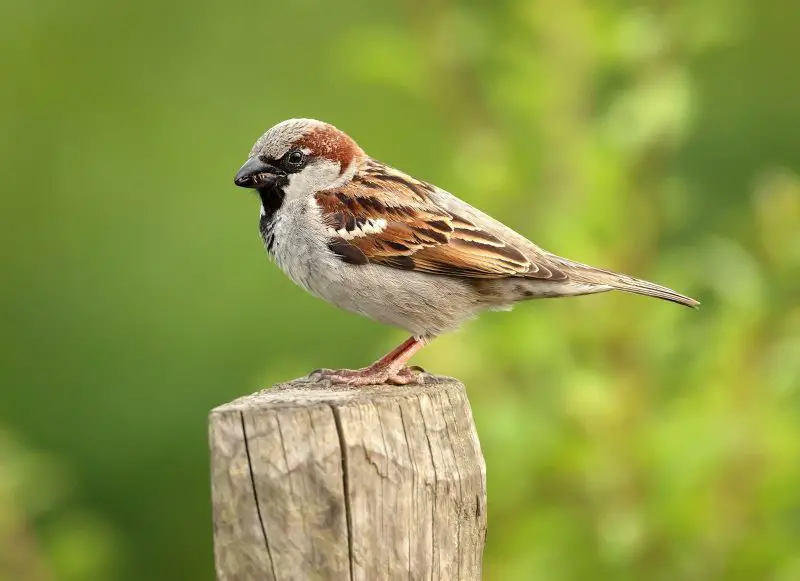
The House Sparrow is a small, stocky bird about 6 inches long, with males displaying gray heads, white cheeks, and a distinctive black bib, while females are more uniformly brown and streaked. Originally introduced from Europe, House Sparrows have become widespread across Virginia’s urban and suburban areas. They are often seen near human habitation, scavenging for food and nesting in building crevices.
House Sparrows have a diverse diet, feeding on seeds, grains, insects, and food scraps from humans. Their adaptability and aggressive behavior allow them to outcompete some native birds for nesting sites and resources. They are social birds, commonly found in flocks that communicate with chirps and chattering calls.
Despite sometimes being viewed as pests, House Sparrows play a role in controlling insect populations and providing prey for raptors. Their close association with humans makes them one of the most familiar birds in Virginia’s neighborhoods and city parks.
European Starling
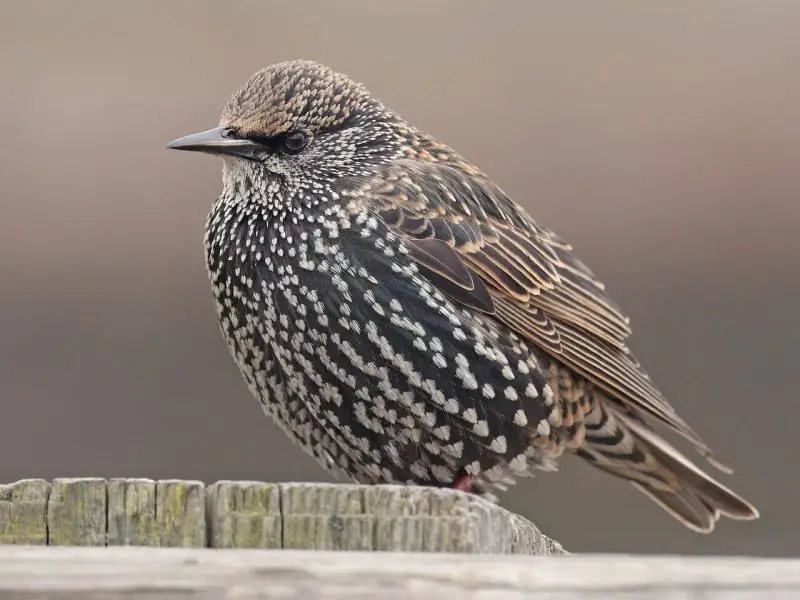
The European Starling is a medium-sized bird about 8 inches long, with glossy black plumage that shines iridescent purple and green in sunlight. It has a long, pointed yellow bill and short tail. Introduced to North America in the late 1800s, starlings have become one of the most common and widespread birds in Virginia, often seen in large flocks in cities, farmland, and open fields.
European Starlings have a varied diet that includes insects, fruits, seeds, and human food waste. They are excellent mimics and can imitate the calls of other birds and sounds from their environment. Their large, noisy flocks, known as murmurations, create impressive aerial displays that are a popular spectacle in Virginia during migration seasons.
Starlings nest in cavities but often compete aggressively with native birds for nesting sites. Their adaptability to urban environments has allowed them to thrive, but they are sometimes considered invasive and a nuisance. Despite this, their striking iridescence and complex social behaviors make them a fascinating species to observe.
Common Grackle
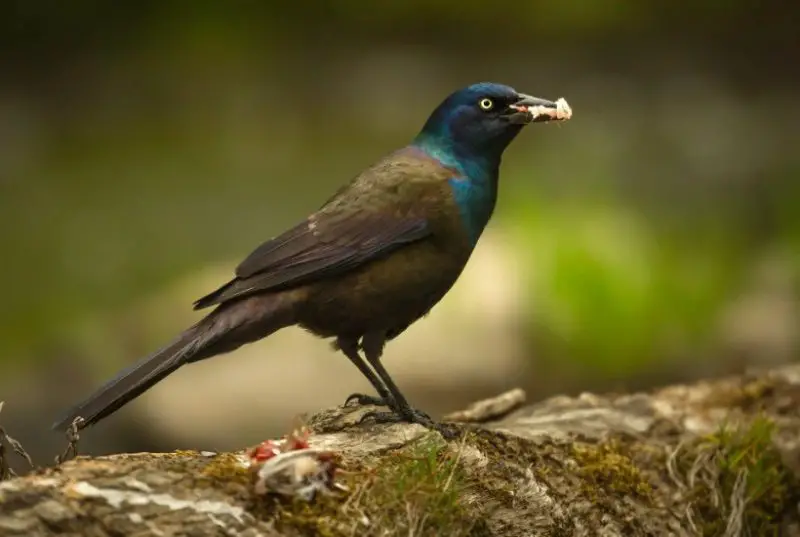
The Common Grackle is a large blackbird about 12 to 13 inches long, with glossy black plumage that often shows iridescent purple, green, and bronze hues in sunlight. It has a long tail and a strong, pointed bill. Common Grackles are widespread in Virginia and inhabit open woodlands, wetlands, parks, and suburban areas. They are often seen in large, noisy flocks.
Grackles have an omnivorous diet that includes insects, small animals, seeds, grains, and human food scraps. They are known for their loud, harsh calls and gregarious behavior. Their long tail and bold, iridescent feathers make them easily distinguishable from other blackbirds.
During the breeding season, males display their glossy plumage and perform elaborate courtship rituals to attract females. Although sometimes considered pests due to their opportunistic feeding habits and large flocks, Common Grackles play an important ecological role by controlling insect populations and dispersing seeds in Virginia’s ecosystems.
Barn Swallow
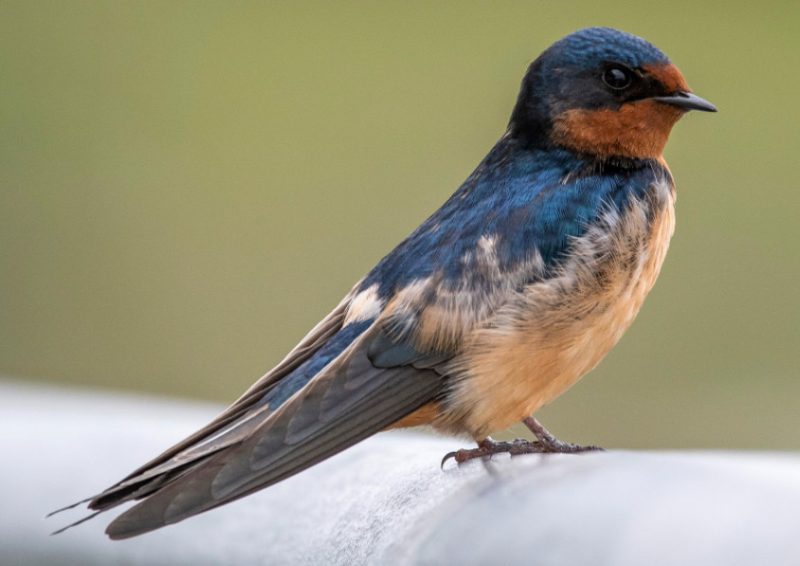
The Barn Swallow is a slender, graceful bird about 7 inches long, with glossy blue-black upperparts, a reddish throat and forehead, and a cream-colored belly. Its deeply forked tail with long outer feathers is a distinctive feature, aiding its agile flight. Common across Virginia, Barn Swallows nest in barns, bridges, and other man-made structures, often forming large colonies.
Barn Swallows feed almost exclusively on flying insects, catching them on the wing with impressive aerial acrobatics. Their diet includes flies, beetles, mosquitoes, and moths, making them beneficial for controlling insect populations. They often forage low over fields, water bodies, and open areas.
These birds build cup-shaped mud nests lined with grass and feathers, frequently returning to the same nesting sites year after year. Their cheerful, twittering calls and acrobatic flight patterns make Barn Swallows a favorite sight in Virginia’s rural and suburban landscapes during spring and summer.
Eastern Kingbird
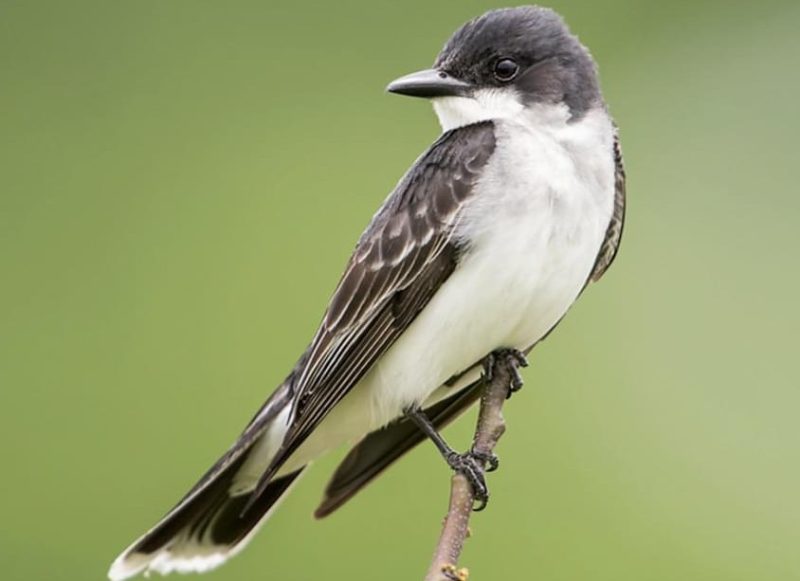
The Eastern Kingbird has a distinctive gray back with a clean white chest, making it easy to recognize. It is a medium-sized bird known for its aggressive behavior during breeding season, often chasing away much larger birds to defend its territory. This species prefers open habitats such as meadows, grasslands, and pastures where it perches conspicuously on fences or shrubs.
In Virginia and other parts of its range, the Eastern Kingbird feeds primarily on flying insects, catching them in midair with swift, acrobatic flights. It also supplements its diet with berries, especially in late summer and fall. Its bold black-and-white coloration and energetic hunting style make it a standout in open fields and rural areas.
A notable behavior of the Eastern Kingbird is its fearless defense of its nest and young, despite its relatively small size. It often swoops aggressively at potential threats, including humans and large birds of prey. This tenacity, combined with its striking plumage and habitat preference, makes it a fascinating species to observe in open landscapes.
Gray Kingbird
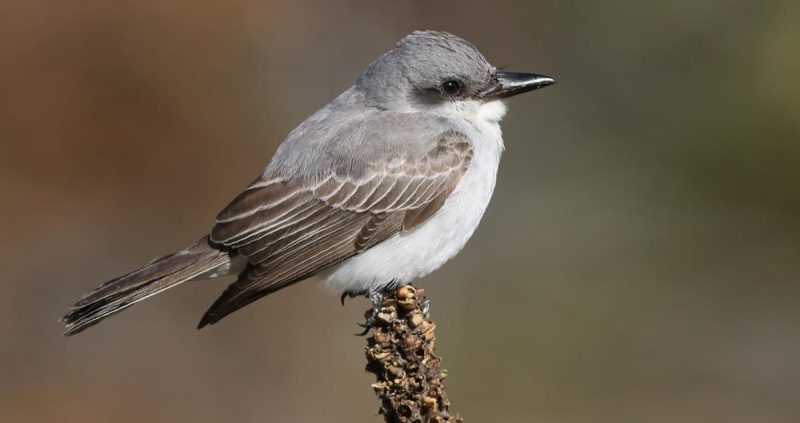
The Gray Kingbird is mostly found in coastal and southern regions, favoring habitats like mangroves, shorelines, and open coastal areas. It has a gray back and contrasting black wings, with a pale underbelly that enhances its sleek appearance. Though less common in Virginia, it can occasionally be spotted during migration or in southern parts near the coast.
Gray Kingbirds are insectivorous, feeding on a wide variety of flying insects caught in flight. They are known for their loud, harsh calls and aggressive territorial behavior, similar to the Eastern Kingbird but generally less widespread. Their bold coloration helps them stand out against the bright coastal skies.
This species often perches openly on wires or exposed branches, scanning for prey. Its coastal habitat preference and robust hunting tactics make it well-adapted to the warm southern environments where it is most commonly found. Birdwatchers along Virginia’s coastal areas may catch rare glimpses of this striking kingbird.
Rock Pigeon (Rock Dove)
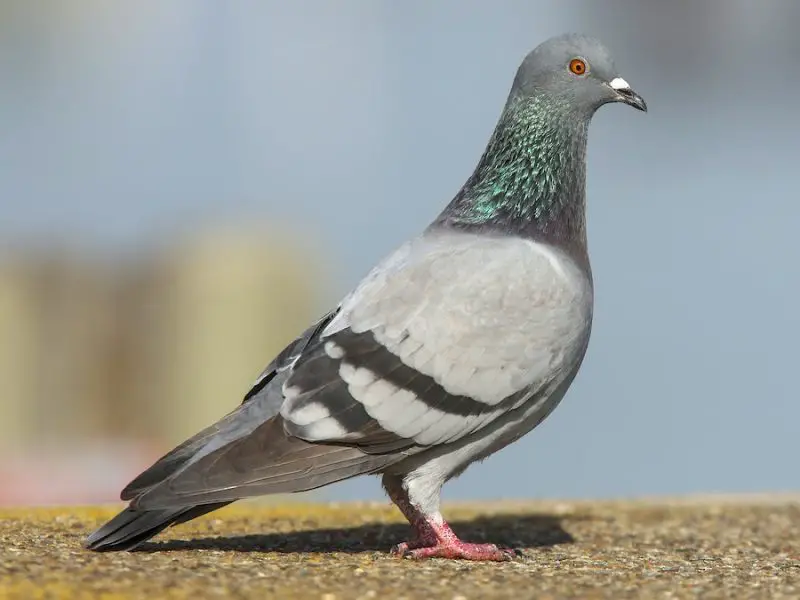
The Rock Pigeon, commonly called Rock Dove, is one of the most familiar birds in urban environments across Virginia and beyond. These pigeons exhibit a wide range of gray shades, from light silvery tones to darker slate hues, often with iridescent patches of green and purple on their necks. Their stout bodies and rounded heads make them easily recognizable in cities and towns.
Rock Pigeons thrive in metropolitan areas, nesting on buildings, bridges, and other man-made structures. Their diet mainly consists of seeds, grains, and human food scraps, which they forage for on sidewalks, parks, and plazas. Their adaptability to urban life has made them one of the most successful city-dwelling birds.
Despite their commonness, Rock Pigeons have interesting behaviors such as elaborate courtship displays involving puffing up their chest and cooing softly. They also have strong homing instincts, historically used in pigeon racing and message delivery. Their presence is a constant reminder of wildlife’s ability to coexist with human civilization.
Ash-throated Flycatcher

The Ash-throated Flycatcher features a light grayish-brown body with subtle ash-gray tones blending into its feathers, giving it a soft and muted appearance. It is typically found in dry, arid regions with sparse vegetation such as deserts and scrublands. While not common in Virginia, it occasionally appears during migration or in particularly dry habitats.
This bird specializes in aerial insect hunting, sallying out from low perches to catch flies, beetles, and other insects mid-flight. It also supplements its diet with small fruits and berries when insects are less abundant. The Ash-throated Flycatcher is known for its distinctive call, a series of clear, whistled notes.
Nesting usually occurs in natural cavities or abandoned woodpecker holes, where the female lays eggs and both parents care for the young. Their preference for dry environments and their subtle coloration help them blend into arid landscapes, making sightings a special treat for birders in the southern U.S.
Sage Thrasher
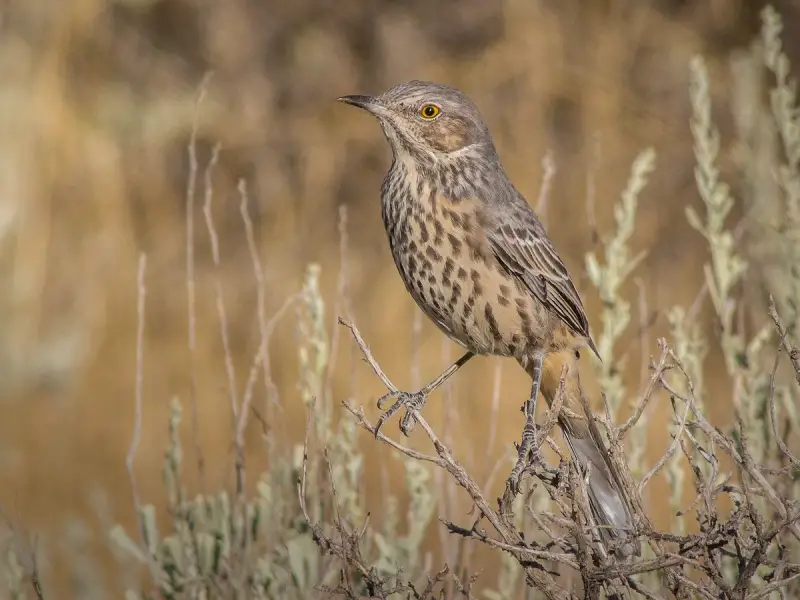
The Sage Thrasher is a medium-sized gray bird commonly inhabiting dry grasslands, sagebrush areas, and dense shrubby thickets. It has a pale grayish-brown back with lighter underparts and subtle streaking on the chest. While it primarily lives in western regions, it occasionally appears in eastern states like Virginia during migration seasons.
This bird feeds on insects, spiders, and other small invertebrates found on or near the ground. It uses its long bill to probe through leaf litter and loose soil in search of food. During the breeding season, the male performs a complex song to attract mates and defend territory, consisting of repeated phrases and mimicked calls.
Sage Thrashers prefer open, dry habitats with low vegetation that offers both cover and foraging opportunities. Their cryptic gray coloration provides excellent camouflage against sagebrush and dry grasses. Observing this species is a unique experience due to its preference for less common, arid habitats.
FAQs about Gray Birds in Virginia
What types of habitats do gray birds prefer in Virginia?
Gray birds in Virginia can be found in a variety of habitats depending on the species. Some, like the Eastern Kingbird, favor open fields and grasslands, while others such as the Rock Pigeon thrive in urban environments. Forested areas attract birds like the Tufted Titmouse and Downy Woodpecker, while coastal zones and thickets are ideal for species like the Gray Catbird and Gray Kingbird.
Are gray birds in Virginia year-round residents?
Some gray birds in Virginia are year-round residents, including the Carolina Chickadee and Tufted Titmouse, which are commonly seen at feeders during all seasons. Others, like the Gray Catbird or Eastern Kingbird, are migratory and usually appear in spring and summer. Always consider the season when identifying birds in your area.
How can I attract gray birds to my backyard?
To attract gray birds to your yard, provide a mix of native shrubs, trees, and bird feeders. Suet and sunflower seeds appeal to species like the Downy Woodpecker and White-throated Sparrow, while fruit-bearing plants can attract birds such as the Northern Mockingbird. A bird bath with clean water will also help draw in a wider variety of species.
Are there any invasive gray bird species in Virginia?
Yes, the European Starling and House Sparrow are two examples of non-native gray-toned birds that have established large populations across Virginia. They often compete with native species for nesting sites and resources, but they are still a common sight in backyards and city areas.
Do male and female gray birds look different?
In some gray bird species, males and females look very similar, such as the Gray Kingbird and Ash-throated Flycatcher. However, in species like the House Finch, males tend to have some reddish coloring that females lack. It’s always helpful to observe behavior and vocalizations, in addition to color, for accurate identification.

